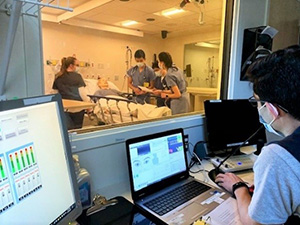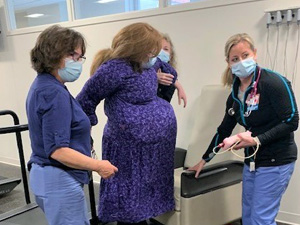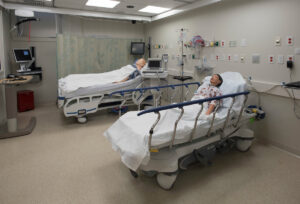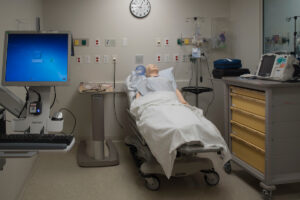Shipley Simulation Center
The mission of the Shipley Medical Simulation Center (SMSC) is to improve the experience and quality of care our patients receive by providing evidence-based education and training for our staff. Located in the basement of the Ellison Building, the SMSC was founded in 2011 with the purpose of providing comprehensive education and training to Newton-Wellesley Hospital’s clinical staff.
The center is comprised of two patient rooms that are fully wired for audio and video for playback and live viewing of simulations. These rooms can simulate a standard medical-surgical room, a pediatric room, the ICU, or an operating room. The SMSC houses four high-fidelity computerized manikins which can be controlled by an instructor. The manikins can breathe, talk, and have pulses, heart tones, lung sounds, bowel sounds and more to create the most immersive experience possible. The SMSC has many task trainers for clinical staff to hone their skills, such as intubation and paracentesis trainers. In addition to the simulated rooms, the SMSC has two debriefing rooms, one of which has a small computer lab.
What is Simulation?
Simulation provides the opportunity for learning that is both immersive and experiential. The staff at Newton-Wellesley Hospital are using experiential learning in many ways such as static and interactive manikin simulators, task trainers, and screen-based (computer) simulations. Simulation allows individuals to develop skills, both clinical and behavioral, in a safe and organized manner. By recreating scenarios that are rarely experienced in the clinical setting, our teams will be better prepared and trained in emergency crisis management.
Beyond the impact on individual and team performance, simulation techniques learned in our simulation center provide an opportunity to improve system performance. In addition to practitioner inexperience, most medical errors are systems-related and not attributable to individual negligence or misconduct. Practicing techniques in our simulation center may help to reduce medical errors, improving patient safety.
Our Facilities
The SMSC is equipped with four state-of-the-art computerized manikins that display symptoms and signs the same way people do. At times standardized patients and family members are also used to enhance the experience by adding more realism to the scenarios. Each room is fully wired for audio and video, so faculty members can observe students’ performance. The two simulation rooms currently simulate a medical surgical room and a pediatric room but can also be made into an ICU or operating room.
The SMSC is here to help make your next simulation a successful one! We will work with you to design and build simulation experiences that inspire critical thinking, collaboration, and promote learning and growth. We are able to provide many services, including debriefing rooms. If you are interested, you may make a reservation online.
Simulation Using the SMSC’s Facilities
The SMSC has access to a wide range of technologies that allow us to create high-fidelity simulations. Several classes consistently use our facilities, including weekly simulations run by our Chief Medical Resident for medical students, physician assistant students, and interns, and Newton-Wellesley’s Patient Care Associate training class.
ACLS and PALS are also hosted at the SMSC. In order to make simulations as realistic as possible, the simulation lead usually sits in our Control Room and can observe participants through a one-way mirror and can speak to and hear them using our A/V system. Our computerized manikins can also be fully controlled from this room.
In-Situ Simulation
We can also come to you! Running a simulation on your unit brings a level of realism to the scenario. Much of our technology is portable and can be brought to you. For example, we designed and ran two drills for Cardiac Rehab, where the nurses, physical therapist, dietician, and support staff had to respond to abnormal cardiac rhythms and activate a Medical Assist. Running drills on-unit allows for full staff participation. It can also reveal potential areas for improvement on the unit itself, allowing for the identification of potential deficiencies in the environment that could be changed to promote patient and staff safety.
The larger patient room (on the left) can fit two manikins. On the right, you see the Sim Man 3G, an advanced simulation manikin capable of replicating a variety of patient conditions.Our two patient care rooms replicate hospital conditions as closely as possible.
Debriefing Rooms
The SMSC has two debriefing rooms for post-education meetings and conferences. These high-tech meeting rooms feature widescreen TVs and fully networked video playback systems to allow for a full discussion of the simulation and additional teaching to review what happened in the simulation. Trainers and observers can even watch the simulation unfold on the television through the closed-circuit video system.
Simulators
Our life-like manikins add to the experience of the simulation. Healthcare providers are able to train in a safe and realistic environment before seeing the same complication or emergency in our hospital. Our manikins have many functions that help engage learners, including heart sounds, lung sounds, and pulses. Learners can also perform procedures such as catheter placement and IV access.
Meet our manikins:
- SimMan3G© is an adult manikin.
- SimMom© is a maternity birthing manikin.
- SimJunior© is a 4-6-year-old child.
- SimNewB© is a newborn.
- ResusciAnne© allows learners to practice the proper mechanics of CPR. This manikin measures the rate and depth of compression which is helpful feedback to improve performance.
Task Trainers
Clinicians refine their technical skills through task trainers. Just like going to the batting cages in baseball, task trainers allow for clinicians to practice proper mechanics of a skill and build muscle memory with coaching and corrective feedback.
- Airway trainers
- Paracentesis
- Intraosseous access
- Intravenous access
- Arterial blood sampling
- Lumbar puncture
- Urinary catheter placement
- Automatic External Defibrillator trainer
Working with Industry
Simulation can also be a valuable tool for industry, especially sales staff and product developers. We work with medical device and pharmaceutical companies to set up simulated environments for testing of new technologies from the genesis of product development to implementation.
Prototype Testing
The information gathered and lessons learned from testing various clinical situations can provide valuable insight on product performance. We’ll develop simulations that mimic a real-life example that your product can be interfaced with. You and your team can observe your device and make any necessary changes from the data that you gather in our simulation rooms.
Clinician Training
When your product is ready for launch, you can use our simulation rooms to properly train the clinical staff to ensure proper use of the device. To ensure the clinical staff will be using the device correctly, we offer our simulation rooms to mimic the actual clinical setting where you can instruct and provide feedback for the clinicians to become as ready as possible.
Debriefing Rooms
The center has two debriefing rooms for post-education meetings and conferences. These high-tech meeting rooms feature widescreen televisions and fully networked video playback systems to allow for a full discussion of the simulation and additional teaching to review what happened in the simulation. Trainers and observers can even watch the simulation unfold on the television through the closed-circuit video system.
Simulators
Life-like manikins add to the experience of the simulation. Healthcare providers are able to train in a safe and realistic environment before seeing the same complication or emergency in our hospital. Our manikins have many functions that help engage learners such as heart sounds, lung sounds, and pulses. Learners can also perform procedures such as catheter placement and IV access.
- SimMan3G© is an adult manikin.
- SimMom© is a maternity birthing manikin.
- SimJunior© is a child about 4-6 years old.
- SimNewB© is a newborn baby.
- ResusciAnne© allows learners to practice the proper mechanics of CPR. This manikin measures the rate and depth of compression which is helpful feedback to improve performance.
Task trainers
Clinicians refine their technical skills through task trainers. Just like going to the batting cages in baseball, task trainers allow for clinicians to practice proper mechanics of a skill and build muscle memory with coaching and corrective feedback.
- Airway trainers
- Paracentesis
- Intraosseous access
- Intravenous access
- Arterial blood sampling
- Lumbar puncture
- Urinary Catheter placement
- Automatic External Defibrillator trainer
Working with industry
Simulation can also be a valuable tool for industry, especially sales staff and product developers. We work with medical device and pharmaceutical companies to set up simulated environments for testing of new technologies from the genesis of product development to implementation.
Prototype testing
The information gathered and lessons learned from testing various clinical situations can provide valuable insight on product performance. We’ll develop simulations that mimic a real-life example that your product can be interfaced with. You and your team can observe your device and make any necessary changes from the data that you gather in our simulation rooms.
Clinician training
When your product is ready for launch, you can use our simulation rooms to properly train the clinical staff to ensure proper use of the device. To ensure the clinical staff will be using the device correctly, we offer our simulation rooms to mimic the actual clinical setting where you can instruct and provide feedback for the clinicians to become as ready as possible.
Shipley Simulation Specialists
Edward E. Hurtwitz, MD
Medical Director of the Shipley Medical Simulation Center
Dr. Hurwitz received his Bachelor of Arts degree in chemistry and biochemistry from Brandeis University. He received a Master of Arts degree in medical sciences from Boston University and an MD degree from Albany Medical College. He did his medical residency at Boston Medical Center. He was recruited to Newton-Wellesley Hospital as a full-time Hospitalist in 2012 and has served as Medical Director of the Shipley Medical Simulation Center since 2019. He has received training at the Center for Medical Simulation (CMS) and completed the Comprehensive Instructor course. As Medical Director, Dr. Hurwitz is involved with integrating simulation education into the hospital system to improve patient care and teamwork. He is a Clinical Assistant Professor of Medicine at Tufts University School of Medicine and a Clinical Associate Professor of Medicine at the Massachusetts College of Pharmacy and Health Sciences University.
Susan Kata Conde, RN, MSN, CEN
Clinical Nurse Program Manager
S. Kata Conde, MSN, RN, CEN is the Clinical Nurse Program Manager of the Shipley Medical Simulation Center. With over 30 years of critical care and emergency nursing experience, Kata is dedicated to creating innovative and multidisciplinary simulation experiences that strengthen teamwork, communication and exceptional patient care. Involved in simulation since 2008, she completed the Simulation-Based Instructor Training Course by the Israel Center for Medical Simulation. Kata holds a Master of Science in Nursing Education and is certified in emergency nursing. When not creating immersive simulation experiences, you are likely to find Kata paddling in her kayak.
Marissa Troy, RN, BSN
Simulation Technician
Marissa Troy is a registered nurse and joined the Shipley Simulation Center in February 2021. Before assuming the role of Simulation Technician, Marissa worked as a labor and delivery nurse for several years and especially enjoys working on obstetric-related simulations. Prior to entering the healthcare field, Marissa received her Bachelor of Fine Arts in Animation and consulted emerging businesses on branding, image design, and go-to-market strategies. She now uses her artistic experience to enhance simulations to make them as realistic as possible.
Elizabeth A. Konig, MD
Obstetrics Course Director
Dr. Elizabeth Konig joined NWH in 1997 and is a Board Certified OB-GYN. Dr. Konig is the Associate Chair of Obstetrics at NWH. She joined the Simulation Center in 2011 as a clinical faculty member. During her tenure at NWH, Dr. Konig has trained at the Center for Medical Simulation and completed the Comprehensive Instructor Workshop. When she’s not busy delivering babies, you can find Dr. Konig teaching the Labor and Delivery Crisis Resource Management Courses and Obstetrical Safety Drills in the Simulation Center and on Labor and Delivery.
Tina Gartley, MD
Pediatric Course Director
Kyle R. Byrne, MD
Anesthesia Course Director



